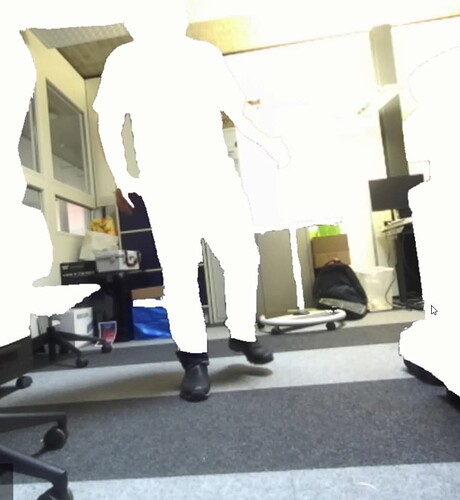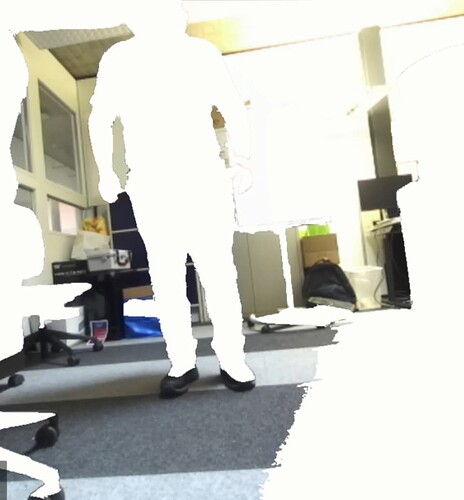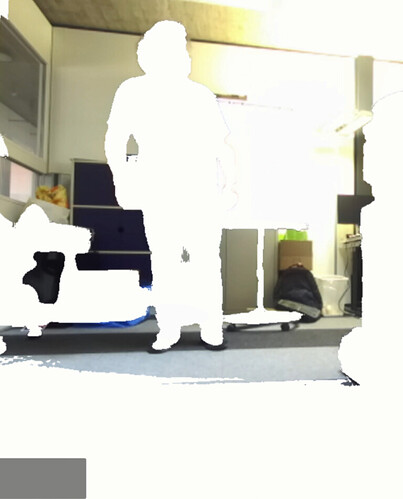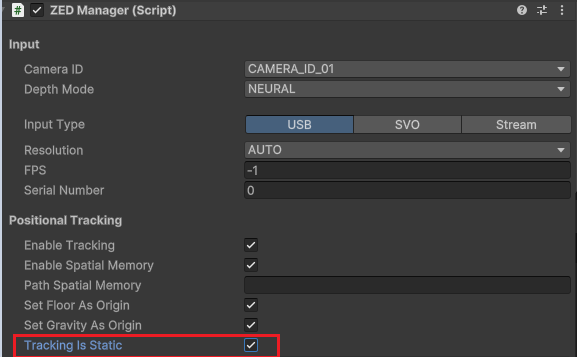Context
-
Unity 6000.0.33, URP
-
ZED Unity SDK 5.0.1
-
I render a humanoid mask in a custom shader using depth. The RGB image is cropped by distance and I subtract the floor using a one-shot Y-height calibration (from
MEASURE.XYZ) to keep the feet while removing the floor. -
Attached screenshot: either the mask stops around the ankles, or, if I widen the band, feet are included but so is the floor and nearby objects.
-
Camera : ZED 2 / ZED 2i
-
Depth mode : Neural Depth Mode
Current results
- Narrow band → mask cuts at the ankles.
- Wider band (
floorHeightBandMeters) → feet included better, but floor starts to leak.
- Even wider band → floor and floor objects included.
Implementation (short)
- Full-screen
Graphics.Blitinto aRenderTexturewith Custom/ZEDMask. - Runtime mask uses
MEASURE.DEPTH. - Floor calibration uses
MEASURE.XYZ; I take Y (meters) to build a “Floor”RenderTexturethat I subtract in the shader. - Key knob:
floorHeightBandMeters(tolerance around floor height).
Minimal C# excerpt (param passing)
public void CalibrateFloor()
{
Texture rgb = zedPlane?.TextureEye;
if (rgb == null || maskMaterial == null) return;Texture xyzTex = zedCamera != null ? zedCamera.CreateTextureMeasureType(sl.MEASURE.XYZ) : zedPlane?.Depth; if (xyzTex == null) return; int w = rgb.width, h = rgb.height; if (floorRT == null || floorRT.width != w || floorRT.height != h) { if (floorRT != null) floorRT.Release(); floorRT = new RenderTexture(w, h, 0, RenderTextureFormat.ARGB32); floorRT.Create(); } maskMaterial.SetFloat("_HasFloor", 0f); maskMaterial.SetTexture("_FloorTex", Texture2D.blackTexture); maskMaterial.SetTexture("_DepthTex", xyzTex); maskMaterial.SetFloat("_UseYFloor", 1f); maskMaterial.SetFloat("_FloorY", floorHeightMeters); maskMaterial.SetFloat("_FloorYBand", floorHeightBandMeters); maskMaterial.SetFloat("_BuildFloor", 1f); Graphics.Blit(rgb, floorRT, maskMaterial); maskMaterial.SetFloat("_BuildFloor", 0f); floorReady = true;}
Minimal C# Shader
// — Build floor mode: mark floor pixels (Y close to _FloorY) —
if (_BuildFloor > 0.5)
{
float3 P = depth.rgb; // XYZ in meters (camera space)
if (all(P == 0)) return half4(0,0,0,1);float dy = abs(P.y - _FloorY); float isFloor = step(dy, _FloorYBand); return half4(isFloor, isFloor, isFloor, 1);}
// — Runtime: combine mask and floor subtraction —
float4 maskRaw = SAMPLE_TEXTURE2D(_MaskTex, sampler_MaskTex, uv);
float4 maskCol = float4(maskRaw.b, maskRaw.g, maskRaw.r, maskRaw.a);
Works
-
Distance-based mask

-
Y-based floor subtraction
 (generally)
(generally) -
Feet vs floor

Issue
- Feet vs floor boundary is unstable: either ankles get cut, or floor leaks into the mask when widening the band.
Tried
-
floorHeightBandMeters0.02–0.08 m -
Floor normal dot thresholding
Questions
I currently build a floor mask from a Y-band (MEASURE.XYZ) and subtract it from a DEPTH-based humanoid mask.
- Is there a better way to make the feet vs floor split more robust?
- Is
MEASURE.XYZY strictly in camera space (roll-independent), or should I transform camera→world to stabilize floor height?



